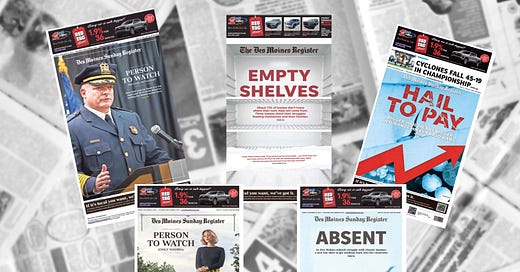One of the trends in modern journalism that I find distressing is the declining importance of the lead story.
During my career in radio and TV news, we sweated bullets over “what are we going to lead with tonight?” Each day, we had a roster of stories our staff was working on. But were any of them good enough to lead the newscast?
On the print side, editors would try to figure out what to put “above the fold” and in the topmost position. In that way, editors communicated to viewers what, in their judgment, was the most important thing for them to read that day.
What makes for a good lead? In my view, a lead story should have many, and ideally ALL, of these elements:
· Importance.
· Impact on viewers’ or readers’ lives.
· A good human-interest angle – an interview with people directly affected by the situation.
· In the case of television, strong visuals.
· Bonus points for an exclusive story that the competition doesn’t have. We would salivate over the prospect of having a good exclusive story we knew the competition didn’t have, imagining the groans that would go up in their newsroom when they saw our big lead. Yes, journalists are that competitive. OK, and maybe a little petty!
Some days, the lead story is obvious. A tornado. A plane crash. Rioters storming the U.S. Capitol. (Like that would ever happen.) But most days, we would have to dig up a good lead story by working sources and knocking on doors. The old rap on TV news was “if it bleeds, it leads”. Perhaps true at one time, but newsroom managers are more sophisticated today.
In the newsroom where I worked for nearly 40 years, we would have multiple meetings throughout the day to discuss the merits of the stories we were working on and what to lead with. Once we decided what we were going to lead with at 6:00 pm, we would work hard to try to find a different story to lead at 10:00 pm. Why? Well, we wanted something new to attract viewers who had already watched our early newscast. And we wanted to prove to viewers that we were out working all evening long for them, too.
All of that is going by the wayside these days, both in broadcast and print.
Take a look at this past Sunday’s front page of the Des Moines Register print edition:
The entire front page is taken up by ONE story. All readers see is a big graphic about property taxes. And there’s not even any copy to read on the front page. The details are inside.
The Register has been doing this every Sunday for months. A big picture of the new Des Moines police chief, or a profile on a young community leader. These are stories that could be done ANY day. There’s not any real news from the weekend on the front page of the Sunday Register anymore.
What’s the reason?
My guess is the reason for the trend is the early deadline the Register faces, sometime late afternoon the day before publication. Rather than fill the front page with three or four stories that look like old news by Sunday morning, the paper has decided to plan it out in advance and go with one enterprise story.
And it’s more evidence of the decline of the print edition. Why worry about the lead story when most readers are simply scrolling through their news app? (The Dubuque Telegraph Herald and the respected Cedar Rapids Gazette announced this week that they’re cutting back to printing newspapers only three days a week.)
On the broadcast side, the importance of the lead story has waned due to the proliferation of local newscasts. There are so many now. All morning long, at noon, 4pm, 5pm, 9pm and 10pm. Few cities are busy enough news towns to justify that many great lead stories. Viewers end up with a lot of re-hash.
I want to know what the editors think is important
The lead is important in the digital world, too. I like to see what the New York Times puts high on its news app. I want to see how often the lead story changes throughout the day. I want to trust that the editors are using their skill and experience to curate what I need to know.
Call me old fashioned, but I still think the lead story is important. It should grab a busy audience’s attention. It should say, “Look – this is important!” Too often these days, it seems like an afterthought. I urge news managers to continue to advocate for the strongest lead story possible.
A proud member of the Iowa Writers’ Collaborative. Click here to see our updated roster of writers.







Good post that underscores the changing pace of media.
Here’s the lead starting Monday for 4 years:
King Trump, the convicted felon seditious liar, supported by a spineless GOP, caused more chaos today, going after everyone who hasn’t kissed his ring, wreaking havoc on the nation and the world, demeaning the Office of the President, enjoyed another day on his golf course with his billionaire buddies and his friend Putin.